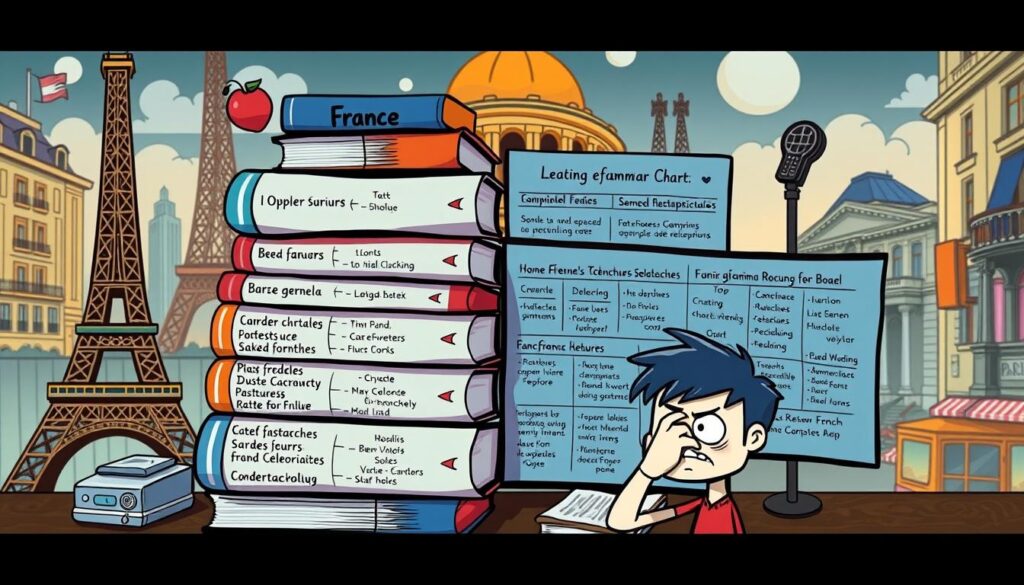If you’ve mastered Spanish to an advanced level, reaching C1 proficiency, you might wonder, “is it easier to learn French after?” Learning languages opens up a world of questions, especially about language interference. Could learning French affect your Spanish skills?
Studies show French and Spanish have a 75% similarity in vocabulary. This could make learning French easier for Spanish speakers. However, there’s a risk of forgetting some Spanish. Each person’s experience with learning languages is unique. Learning Spanish and French one after the other immerses you in different linguistic aspects.
Some people enjoy learning new grammatical patterns. They use their Spanish skills to help with French. But everyone’s language learning journey is different. Success depends on how similar the languages are and how often you use them.
Choosing French or Spanish is about more than academics. It’s about connecting with the culture and where the language is spoken. Whether you’re exploring for strategic reasons or love the sound of French, learning a language is a journey without end.
The Relationship Between Spanish and French Language Skills
Discovering how Spanish and French learning intertwines offers a look into cognitive skills and cultural depths. When you start learning multiple languages, especially related ones, the benefits of learning multiple languages shine through. The common Latin roots help with vocabulary and grammar. They also make the whole learning process smoother.
Understanding Language Acquisition Dynamics
Learning Spanish and French is enhanced by their Latin roots. This makes it easier to understand their structures and words. Such an overlap leads to a better language learning strategy. Knowing one language helps in learning the other. Still, it’s important to notice the little phonetic differences. These small details are crucial for language proficiency.
How Spanish Language Proficiency Can Influence French Learning
Being good at Spanish can help you learn French faster. You’ll quickly get the grammar and vocabulary. But, this can also mix up pronunciation and word use. A solid language learning strategy is key. It should include separate study times, listening closely, and learning in context. This helps you switch between Spanish and French easily.
If you’re learning multiple languages, practice both regularly. Here are some tips to keep your skills sharp and avoid mixing up the languages:
- Make a study routine that alternates between Spanish and French for even exposure.
- Practice with online tools that simulate real situations or dive into each language’s media.
- Actively note the similarities and differences in grammar and vocabulary to create separate mental lexicons.
Learning Spanish and French goes beyond words and rules. It’s about grasping what makes each culture unique. With the correct approach, the benefits of learning multiple languages outweigh the difficulties. These include better thinking skills, improved problem-solving, and deeper cultural insights.
Linguistic Similarities and Differences: A Closer Look
Diving into Romance languages like Spanish and French shows us both similarities and differences. These are key for coming up with a smart language acquisition strategy. Learning one after knowing the other offers an interesting challenge.
Both Spanish and French have a clear grammar structure. This makes learning a bit easier. Yet, they don’t share much vocabulary, and their sounds vary. Spanish is often seen as simpler to pronounce due to its consistent sounds.
This suggests that learning Spanish might be faster than French. With hard work, reaching proficiency in Spanish can take 2-3 years.
Meanwhile, French comes with more challenges like irregular spellings and tricky pronunciation. These add to the effort needed to master it. Achieving a high level in French, such as DELF B2 or DALF C1, could take about three years of study, assuming 15 hours a week.
| Statistic Opportunity | Spanish | French |
|---|---|---|
| Number of Global Speakers | Over 500 million | Over 270 million |
| Phonetic Complexity | More phonetic/easier pronunciation | Less phonetic/more complex pronunciation |
| Learning Period for Proficiency | Possible in 2-3 years | Generally takes around 3 years |
Spanish can boost your career in the Americas. French can help in fields like aeronautics and telecommunications in Europe and Africa.
It’s important to think about these differences when planning your language acquisition strategy. For deeper insights on language learning, check out more about whether French is a hard language to learn.
Is It Easier to Learn French After Spanish?
The order you learn languages in can make a big difference. Many start with Spanish because it’s phonetically simple and widely used. Does getting good at Spanish make it easier to pick up French? Let’s see what those who have learned multiple languages say.
Analyzing the Language Learning Process
It’s key to know how French and Spanish are structured. They are part of the same language family, sharing many words and grammar rules. Yet, there are differences. Spanish has 17 verb tenses and moods, but French uses 11 in daily life. Finding the right study methods by understanding these details helps. Check out this guide for more tips.
Real-Life Experiences of Polyglots
Polyglots say that Spanish’s complexity, with four words for “you,” sets a strong grammatical foundation. This makes learning other Romance languages like French easier later on. Spanish’s pronunciation helps beginners too. So, knowing Spanish well might make French’s sounds and grammar more approachable. This shows how important the order of learning languages can be.
| Feature | Spanish | French |
|---|---|---|
| Verb Tenses/Moods (daily use) | 14 | 11 |
| Words for “You” | 4 | 2 |
| Subjunctive Use | More complex, multiple tenses | Mainly after “que” |
| Phonetic Character | Easier for beginners | Challenges with sounds like “R” |
| Learning Difficulty (initial) | Marginally easier | Similar to other Indo-European languages |
Learning French after Spanish could be easier with the right foundation. Being strategic and consistent is key to mastering them. It’s all about how you apply what you’ve learned and keeping up with practice.
The Challenge of Language Interference: When Spanish Complicates French
When you’re learning more than one language, you might face a challenge called language interference. This happens a lot for folks learning French after Spanish. You might find bits of Spanish creeping into your French, which can make things tricky.
Language interference shows up in several ways. You might use Spanish sounds or grammar when you’re trying to speak French. For instance, you might pronounce French words the way you would in Spanish. This can really affect how well you speak and understand French.
To get better at French, you need to focus on what makes it unique. Work on French sounds, like the nasal tones, and the special connections between words. French and Spanish treat the gender of nouns differently, too. So, you have to practice a lot to get these right.
Here are some tips to help you deal with language interference:
- Immersive Exposure: Dive into French media and talk with native speakers. It’s one of the best ways to get used to the real sound of the language.
- Targeted Practice: Do exercises that make you use only French. Try not to translate in your head from Spanish.
- Language Separation: Plan your study time so you have certain days or hours just for French or Spanish. It helps keep the two languages separate in your mind.
Beating language interference is key to learning languages well. It makes you better at languages and makes learning them more fun. Eventually, switching between languages gets easier. This skill is great for your personal and work life.
Optimizing Your Language Learning Strategy
Starting to learn many languages is ambitious and enriching. Learning more languages brings many benefits, like better thinking skills and understanding different cultures. We will look at the best ways and order to learn languages to improve your skills.
Effective Methods for Learning Multiple Languages
Choosing a smart approach makes learning languages easier. It’s important to start with languages that are similar, like French and Spanish. This way, you can use the same words and grammar rules in both. Yet, using different tools and ways to learn is key for a good learning setting. Check out this guide for useful tips on learning more than one language.
Language Learning Order and Impact on Retention
The order you learn languages in matters a lot for remembering and using them well. Starting with languages like your own helps build confidence and a strong base. Adding harder languages slowly makes it easier to remember them. Below is a suggested order for learning based on how similar languages are:
| Starting Language | Second Language | Third Language | Notes |
|---|---|---|---|
| English | Spanish | French | Both languages share many cognates with English, easing vocabulary acquisition. |
| Spanish | French | Italian | Progressing within the Romance language family maximizes transferable grammar and vocabulary skills. |
| German | Dutch | Swedish | These Germanic languages have similar syntax and some vocabulary, enabling smoother transitions. |
Learning languages in a certain order isn’t just easier, it also helps stick to it by preventing burnout. Taking breaks and reviewing old languages ensures you remember them even as you learn new ones.
Language interference is a common issue for those who know many languages. Using spaced repetition avoids this by keeping languages distinct. Body language and changing contexts also help keep languages separate in your mind.
Practicing regularly is key to mastering several languages. It means using each language often to get better and avoid mixing them up. You might practice different languages on different days or use them in different areas of your life.
Following these strategies will not only improve your language skills. It will also bring many benefits, like better thinking abilities and job opportunities. The rewards are truly great and varied.
Cultivating Language Proficiency Without Losing Fluency
Mastering multiple languages is like running a marathon, not a sprint. Getting good at a language takes time. For example, Group 1 languages might need 480 hours to learn. Harder languages can require over 720 hours. To keep your language skills sharp, you need regular practice. This could mean joining conversation groups, making friends who are native speakers, or enjoying media in that language.
Studying regularly is key to getting better at a language. If you want to reach a B2 level quickly, say in 6 months, you’d need to study more than 4 hours every day. It’s a lot, but it’s how you get better. Achieving B2 means you can chat about various topics comfortably. But, it’s tough to find enough time every day. Tools like LingQ help a lot. They offer lessons and loads of content for both computer and phone users, making learning easier.
Understanding tricky parts of a language can actually boost your skills. Like figuring out misleadingly similar words or why some nouns have genders. Wordreference.com is a great place for explanations. Also, writing your own sentences and skipping the memorizing of long word lists can help. When you learn actively and use new words often, your skills in languages like French or Portuguese improve a lot. They won’t just get better; they’ll flourish.


